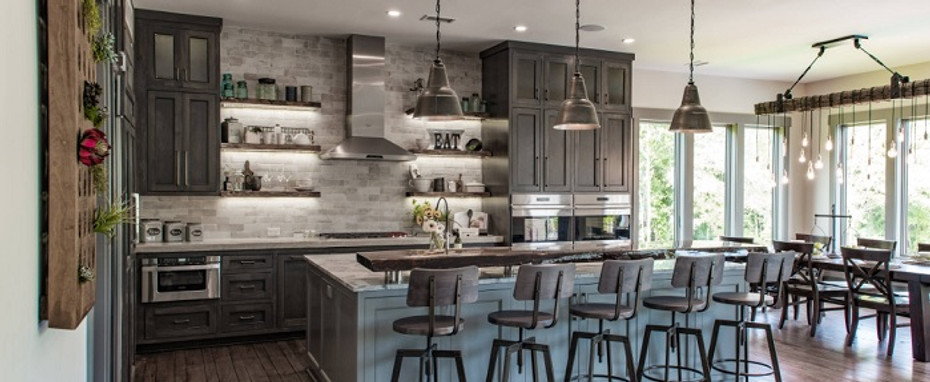Layered Lighting: Making Your Space Stand out
Aug 13th 2020
Good lighting is not something that people often notice. In fact, while people may notice and appreciate the fixtures themselves, the light they emit and how and where it falls to illuminate the space isn’t something that most guests, customers, or workers will notice. Good lighting, like good road safety measures or good film editing is something most people only notice when it’s lacking. Light, shadow, and contrast must all work together and be brought into balance to provide the appropriate light to each space and function within it.
Whether you’re looking to light your home, shop, workshop, or office, the best way to ensure optimal lighting is through the use of layers. We’ve discussed the various layers of lighting before in these previous posts about ambient, task, decorative, and accent lighting. We’ve also talked about color temperature and CRI. A dark, poorly, or insufficiently lit space is often not a comfortable space. Especially if that dim atmosphere isn’t intentional. Putting all of this together will help ensure you get the most out of your space.
Use your layers
Every room should ideally contain each of the four lighting layers. Ambient lighting, the main light for your room, is likely the first light you think of and often where most people consider the job done. Ambient or general lighting is typically what you flick on when you enter a room. Usually a ceiling fixture, general lighting illuminates your space and provides the majority of the lighting for the room.
Task lighting should not be overlooked. It’s often the difference between a good space and an exceptional one. Being able to see precisely what it is you’re doing, whether that’s cooking a meal, reading a book, playing a board game, or working on that eleventh-hour presentation, task lighting is essential. Task lights have their place in every room: in kitchens for cooking, bathrooms for grooming, bedrooms and living rooms for reading, dining rooms for eating or other activities like playing board games, in offices for working on specific projects, and in workshops for illuminating details and avoiding accidents.
For the purposes of this discussion, decorative and accent lighting can be grouped together. Decorative or accent lighting can include table or floor lamps, wall fixtures, or picture lights that give added interest and highlight objects or architectural features within the room. Decorative and accent lighting are the most creative forms of lighting and allow you to put some depth and context to the design.
If you’re concerned about how to accent your room and are reluctant to invest undue money on an expensive fixture, often you can try out a few things before you commit to buying a new lamp. We’d recommend wandering around the room with a lamp borrowed from another room and try plugging it in at different locations. If you like the effect of the light when you hold it in close to the wall, choose a new lamp that is narrow. Try at altering height levels, perhaps next to your favorite object and feature in the room and if you like the effect try to replicate it with either fixed wall lights or table lamps.
Lampshades make a difference too, darker colors will hold more light in and lighter colors let more light out. The color of the room also alters the color of light you get following the same traits. Rooms painted or decorated in darker colors will require more light fixtures to illuminate them to the same relative effect as a light-colored room. Pockets of brighter light in dark spaces can create a very dramatic effect.
Color temperature and CRI
Not only is it important to choose the right color temperature, it’s also important to make sure that your color temperature is consistent within each room or space. Kitchens, bathrooms, and commercial offices often benefit from 5000K daylight while more intimate spaces like most sit-down restaurants, living rooms, home dining rooms, and bedrooms benefit from 2700K - 3000K warm white colors. Often mixing color temperatures in the same room, let alone the same fixture, is distracting and unappealing. Making sure you have the appropriate and same color lights in your space is almost as important as having enough light to begin with.
Check out our post here about ways to help keep your color temperature consistent.
Never underestimate the importance of a light with a sufficiently high CRI score. By way of a quick refresher, CRI is a measure intended to compare artificial light, with a natural light source like the sun. The sun would have a CRI of 100, the scale’s maximum. Many fluorescents and early LEDs had scores much lower than that and, as a result, people often complain of not being able to see well when places were illuminated with these dated technologies. New LED lights have much higher CRI scores, rendering color in ways nearly indistinguishable from sunlight or traditional incandescents. It’s important to note that CRI is completely independent of color temperature. Trying to light your space with bulbs that score too low on the CRI will, at best, result in needing many more light sources. The high powered lights often used in outdoor stadiums, for example, have terrible CRI scores, which is one of the reasons so many are required to adequately light the fields at night. SunLake’s LEDs all have a CRI of at least 80, perfectly adequate for any home, office, restaurant, or store use.
No matter what fixtures you choose, what your style or preference, high quality layered lighting is crucial to getting the most out of your space and SunLake Lighting has the best LEDs on the market.
Below is a selection of just a few of the bulbs SunLake offers. For a complete list of products, click here.


